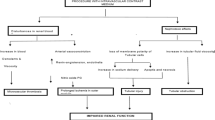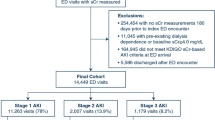Abstract
Objective
Acute kidney injury (AKI) is an important risk factor for a number of adverse outcomes including end-stage renal disease and cardiovascular morbidity and mortality. Whilst many clinical situations that can induce AKI are known—e.g. drug toxicity, contrast agent exposure or ischemia during surgery—targeted preventive or therapeutic measures are still lacking. As to renoprotective strategies, remote ischemic preconditioning (RIPC) is one of the most promising novel approaches and has been examined by a number of clinical trials. The aim of this study was to use blood oxygenation level-dependent (BOLD) MRI as a surrogate parameter to assess the effect of RIPC in healthy volunteers.
Materials and methods
In this IRB-approved, prospective study, 40 healthy volunteers were stratified with 20 undergoing an RIPC procedure (i.e. RIPC group) with a transient ischemia of the right arm, and 20 undergoing a sham procedure. Before and after the procedure, both kidneys of all participants were scanned using a 12-echo mGRE sequence for functional BOLD imaging at 3T. For each volunteer, 180 ROIs were placed in the cortex and the medulla of the kidneys. Ultimately, R2* values, which have an inverse correlation with the oxygenation level of tissue, were averaged for the RIPC and control groups.
Results
Following intervention, mean R2* values significantly decreased in the RIPC group in both the cortex (18.6 ± 2.3 vs. 17.5 ± 1.7 Hz; p = 0.0047) and medulla (34 ± 5.2 vs. 32.2 ± 4.2 Hz; p = 0.0001). However, no significant differences were observed in the control group.
Conclusion
RIPC can be non-invasively assessed in healthy volunteers using BOLD MRI at 3T, demonstrating a higher oxygen content in kidney tissue. This study presents a first-in-man trial establishing a quantifiable readout of RIPC and its effects on kidney physiology. BOLD measurements may advance clinical trials in further evaluating RIPC for future clinical care.




Similar content being viewed by others
References
McCullough PA, Adam A, Becker CR, Davidson C, Lameire N, Stacul F, Tumlin J, CIN Consensus Working Panel (2006) Epidemiology and prognostic implications of contrast-induced nephropathy. Am J Cardiol 98:5K–13K
Persson PB, Tepel M (2006) Contrast medium-induced nephropathy: the pathophysiology. Kidney Int Suppl 100:S8–10
Liss P, Nygren A, Olsson U, Ulfendahl HR, Erikson U (1996) Effects of contrast media and mannitol on renal medullary blood flow and red cell aggregation in the rat kidney. Kidney Int 49:1268–1275
Subramaniam RM, Suarez-Cuervo C, Wilson RF, Turban S, Zhang A, Sherrod C, Aboagye J, Eng J, Choi MJ, Hutfless S, Bass EB (2016) Effectiveness of prevention strategies for contrast-induced nephropathy: a systematic review and meta-analysis. Ann Intern Med 164:406–416
Davenport MS, Cohan RH, Ellis JH (2015) Contrast media controversies in 2015: imaging patients with renal impairment or risk of contrast reaction. Am J Roentgenol 204:1174–1181
Mitchell JR, Verweij M, Brand K, van de Ven M, Goemaere N, van den Engel S, Chu T, Forrer F, Müller C, de Jong M, van IJcken W, IJzermans JN, Hoeijmakers JH, de Bruin RW (2010) Short-term dietary restriction and fasting precondition against ischemia reperfusion injury in mice. Aging Cell 9:40–53
Cochrane J, Williams BT, Banerjee A, Harken AH, Burke TJ, Cairns CB, Shapiro JI (1999) Ischemic preconditioning attenuates functional, metabolic, and morphologic injury from ischemic acute renal failure in the rat. Ren Fail 21:135–145
Zuk A, Bonventre JV (2015) Acute kidney injury: can remote ischaemic preconditioning prevent AKI? Nat Rev Nephrol 11:512–513
Er F, Nia AM, Dopp H, Hellmich M, Dahlem KM, Caglayan E, Kubacki T, Benzing T, Erdmann E, Burst V, Gassanov N (2012) Ischemic preconditioning for prevention of contrast medium-induced nephropathy: randomized pilot RenPro trial (renal protection trial). Circulation 126:296–303
Meybohm P, Bein B, Brosteanu O, Cremer J, Gruenewald M, Stoppe C, Coburn M, Schaelte G, Böning A, Niemann B, Roesner J, Kletzin F, Strouhal U, Reyher C, Laufenberg-Feldmann R, Ferner M, Brandes IF, Bauer M, Stehr SN, Kortgen A, Wittmann M, Baumgarten G, Meyer-Treschan T, Kienbaum P, Heringlake M, Schön J, Sander M, Treskatsch S, Smul T, Wolwender E, Schilling T, Fuernau G, Hasenclever D, Zacharowski K, RIPHeart Study Collaborators (2015) A multicenter trial of remote ischemic preconditioning for heart surgery. N Engl J Med 373:1397–1407
Zarbock A, Kellum JA, Van Aken H, Schmidt C, Küllmar M, Rosenberger P, Martens S, Görlich D, Meersch M (2017) Long-term effects of remote ischemic preconditioning on kidney function in high-risk cardiac surgery patients: follow-up results from the renal RIP trial. Anesthesiology 126:787–798
Hausenloy DJ, Candilio L, Evans R, Ariti C, Jenkins DP, Kolvekar S, Knight R, Kunst G, Laing C, Nicholas JM, Pepper J, Robertson S, Xenou M, Clayton T, Yellon DM (2016) Effect of remote ischemic preconditioning on clinical outcomes in patients undergoing coronary artery bypass graft surgery (ERICCA study): a multicentre double-blind randomised controlled clinical trial. NIHR J Libr, Southampton (UK)
Zhou C, Jeon Y, Meybohm P, Young PJ, Li L, Hausenloy DJ (2016) Renoprotection by remote ischemic conditioning during elective coronary revascularization: a systematic review and meta-analysis of randomized controlled trials. Int J Cardiol 222:295–302
Zhou C, Bulluck H, Fang N, Li L, Hausenloy DJ (2017) Age and surgical complexity impact on renoprotection by remote ischemic preconditioning during adult cardiac surgery: a meta analysis. Sci Rep 7:215
Pierce B, Bole I, Patel V, Brown DL (2017) Clinical outcomes of remote ischemic preconditioning prior to cardiac surgery: a meta-analysis of randomized controlled trials. J Am Heart Assoc. doi:10.1161/JAHA.116.004666
Menting TP, Wever KE, Ozdemir-van Brunschot DM, Van der Vliet DJ, Rovers MM, Warle MC (2017) Ischaemic preconditioning for the reduction of renal ischaemia reperfusion injury. Cochrane Database Syst Rev 3:CD010777
Kork F, Eltzschig HK (2017) The devil is in the detail: remote ischemic preconditioning for perioperative kidney protection. Anestehsiology 126:763–765
Sukkar L, Hong D, Wong MG, Badve SV, Rogers K, Perkovic V, Walsh M, Yu X, Hillis GS, Gallagher M, Jardine M (2016) Effects of ischaemic conditioning on major clinical outcomes in people undergoing invasive procedures: systematic review and meta-analysis. BMJ 355:i5599
Zhang Y, Zhang X, Chi D, Wang S, Wei H, Yu H, Li Q, Liu B (2016) Remote ischemic preconditioning for prevention of acute kidney injury in patients undergoing on-pump cardiac surgery: a systematic review and meta-analysis. Medicine (Baltimore) 95:e3465
Bei WJ, Duan CY, Chen JY, Wang K, Liu YH, Kiu Y, Tan N (2016) Remote ischemic conditioning for preventing contrast-induced acute kidney injury in patients undergoing percutaneous coronary interventions/coronary angiography: a meta-analysis of randomized controlled trials. J Cardiovasc Pharmacol Ther 21:53–63
Michaely HJ, Metzger L, Haneder S, Hansmann J, Schoenberg SO, Attenberger UI (2012) Renal BOLD-MRI does not reflect renal function in chronic kidney disease. Kidney Int 81:684–689
Prasad PV, Edelman RR, Epstein FH (1996) Noninvasive evaluation of intrarenal oxygenation with BOLD MRI. Circulation 94:3271–3275
Li LP, Thacker J, Lu J, Franklin T, Zhou Y, Papadopulou MV, Solomon R, Prasad PV (2014) Efficacy of preventive interventions for iodinated contrast-induced acute kidney injury evaluated by intrarenal oxygenation as an early marker. Invest Radiol 49:647–652
Vinten-Johansen J, Yellon DM, Opie LH (2005) Postconditioning: a simple, clinically applicable procedure to improve revascularization in acute myocardial infarction. Circulation 112:2085–2088
Kin H, Zhao ZQ, Sun HY, Wang NP, Corvera JS, Halkos ME, Kerendi F, Guyton RA, Vinten-Johansen J (2004) Postconditioning attenuates myocardial ischemia-reperfusion injury by inhibiting events in the early minutes of reperfusion. Cardiovasc Res 62:74–85
Lang SC, Elsasser A, Scheler C, Vetter S, Tiefenbacher CP, Kubler W, Katus HA, Vogt AM (2006) Myocardial preconditioning and remote renal preconditioning: identifying a protective factor using proteomic methods? Basic Res Cardiol 101:149–158
Olenchock BA, Moslehi J, Baik AH, Davidson SM, Williams J, Gibson WJ, Chakraborty AA, Pierce KA, Miller CM, Hanse EA, Kelekar A, Sullivan LB, Wagers AJ, Clish CB, Vander Heiden MG, Kaelin WG Jr (2016) EGLN1 inhibition and rerouting of α-ketoglutarate suffice for remote ischemic protection. Cell 164:884–895
Brezis M, Rosen S (1995) Hypoxia of the renal medulla—it’s implications for disease. N Engl J Med 332:647–655
Persson PB, Hansell P, Liss P (2005) Pathophysiology of contrast medium-induced nephropathy. Kidney Int 68:14–22
Geenen RW, Kingma HJ, van der Molen AJ (2013) Contrast-induced nephropathy: pharmacology, pathophysiology and prevention. Insights Imaging 4:811–820
Wang JH, Ren K, Sun WG, Zhao L, Zhong HS, Xu K (2014) Effects of iodinated contrast agents on renal oxygenation level determined by blood oxygenation level dependent magnetic resonance imaging in rabbit models of type 1 and type 2 diabetic nephropathy. BMC Nephrol 15:140
Zhang Y, Wang J, Yang X, Wang X, Zhang J, Fang J, Jiang X (2012) The serial effect of iodinated contrast media on renal hemodynamics and oxygenation as evaluated by ASL and BOLD MRI. Contrast Media Mol Imaging 7:418–425
Pedersen M, Dissing TH, Morkenborg J, Stodkilde-Jorgensen H, Hansen LH, Pedersen LB, Grenier N, Frokiaer J (2005) Validation of quantitative BOLD MRI measurements in kidney: application to unilateral ureteral obstruction. Kidney Int 67:2305–2312
Tumkur SM, Vu AT, Li LP, Pierchala L, Prasad PV (2006) Evaluation of intra-renal oxygenation during water diuresis: a time-resolved study using BOLD MRI. Kidney Int 70:139–143
Li LP, Vu AT, Li BS, Dunkle E, Prasad PV (2004) Evaluation of intrarenal oxygenation by BOLD MRI at 3.0T. J Magn Reson Imaging 20:901–904
Author information
Authors and Affiliations
Contributions
Siedek: protocol/project development, data collection and management, and data analysis. Persigehl: protocol/project development and data analysis. Mueller: protocol/project development and data analysis. Burst: protocol/project development. Benzing: protocol/project development. Maintz: protocol/project development. Haneder: protocol/project development, data collection and management, and data analysis.
Corresponding author
Ethics declarations
Conflict of interest
The authors declare that they have no conflicts of interest.
Ethical approval
All procedures performed in studies involving human participants were in accordance with the ethical standards of the institutional and/or national research committee and with the 1964 Helsinki Declaration and its later amendments or comparable ethical standards.
Informed consent
Informed consent was obtained from all individual participants included in the study.
Rights and permissions
About this article
Cite this article
Siedek, F., Persigehl, T., Mueller, RU. et al. Assessing renal changes after remote ischemic preconditioning (RIPC) of the upper extremity using BOLD imaging at 3T. Magn Reson Mater Phy 31, 367–374 (2018). https://doi.org/10.1007/s10334-017-0658-4
Received:
Revised:
Accepted:
Published:
Issue Date:
DOI: https://doi.org/10.1007/s10334-017-0658-4




